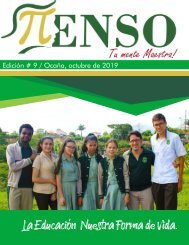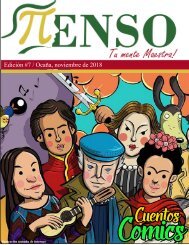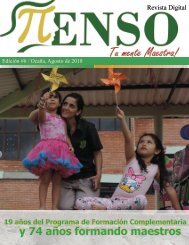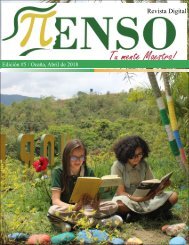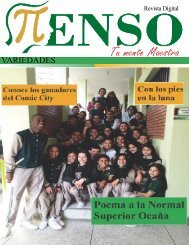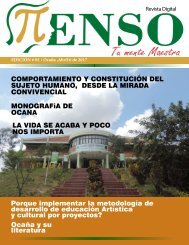You also want an ePaper? Increase the reach of your titles
YUMPU automatically turns print PDFs into web optimized ePapers that Google loves.
mixes the use of technology with<br />
hands-on activities. In an inverted<br />
classroom, typical in-class lecture<br />
time is replaced with laboratory<br />
and in class activities. Outside<br />
of class, lectures were delivered<br />
over some other medium such<br />
as video on-demand. As such,<br />
learning activities, which typically<br />
were done outside of class, were<br />
done in-class in the presence of<br />
the instructor. Passive activities,<br />
such as listening to lectures,<br />
were performed outside of class.<br />
In this opportunity, was used<br />
the podcasting in an inverted<br />
classroom environment with the<br />
explicit goal of reclaiming lecture<br />
time for in-class laboratories and<br />
learning activities, but allowing<br />
the students the opportunity to<br />
perform and create their podcasts<br />
at home too. It is important to<br />
mention the plus that the studies<br />
previous mentioned helped the<br />
present study as a guide and<br />
overview of the advantages of<br />
using podcasting in class. On the<br />
other hand, Brennan Juana and<br />
Deniz Palak (2011) which purpose<br />
was to assess how the use of<br />
podcasting in this high school<br />
Spanish Language class helped<br />
to improve the students speaking<br />
skills in the target language.<br />
To assess the extent to which<br />
podcasting helped to improve the<br />
speaking skills of the students,<br />
Brennan evaluated student<br />
performances in the following<br />
three criteria: (1) Task Completion,<br />
(2) Topic Development, and (3)<br />
Language Use. In an effort to<br />
improve the learning of Chinese<br />
language oral communication<br />
skills, Huann Tan (2006) had<br />
designed a learning environment<br />
mediated by Audioblogs. In this<br />
environment, Audioblogs can be<br />
perceived as a tool that mediates<br />
the interaction between the<br />
subjects, the students; the object,<br />
the students Chinese language<br />
oral performance; and the class<br />
community. Through the mediation<br />
of interactions between these<br />
components, this environment<br />
facilitates the dialectic or<br />
transactional interactions between<br />
the components. This transactional<br />
process was the essence of<br />
social constructivist teaching.<br />
Audioblogs provide the subjects<br />
a medium to refine the Chinese<br />
language oral performance<br />
of students. Reification of the<br />
performances creates artifacts<br />
of the Activity System. Students<br />
could use these artifacts as a<br />
reference for their performance.<br />
For example, students could<br />
model their performance on<br />
examples that the community<br />
rated positively. Students could<br />
also learn from mistakes identified<br />
in performances of other students.<br />
Audioblogs hence mediate the<br />
dialectic between the object<br />
of the students actions, their<br />
performance; and the subjects, the<br />
students. This dialectic between<br />
object and subject alters students<br />
consciousness about their Chinese<br />
language oral performance as<br />
well as the performance itself. The<br />
present study took advantage<br />
of the studies mentioned before<br />
as referent to develop in the<br />
students consciousness of their<br />
own learning process, not just<br />
as an artifact that allow students<br />
to develop certain skills, but<br />
also to awake in the learners a<br />
self assessment and reflective<br />
thought facing their own process.<br />
Moreover, the development of the<br />
study which serves as a precedent<br />
to the present one, was guided<br />
specially by the study conducted<br />
by Brennan Juana and Deniz Palak<br />
(2011) where the researchers used<br />
the model they applied in podcast<br />
assessment, the different types of<br />
podcast assignments and finally<br />
the surveys they developed in order<br />
to get the appropriate information<br />
for their project; in consequence,<br />
similar elements were used in the<br />
present research.<br />
METHODOLOGY<br />
This study was an attempt to<br />
confirm how the creation of<br />
podcasts can improve or even<br />
confront students with what they<br />
really know. In previous studies<br />
conducted in this institution<br />
podcasts implementation showed<br />
efficacy when using and creating<br />
by students from higher levels.<br />
However this study was trying to find<br />
out the efficacy of implementing<br />
this material in lower levels, in<br />
this case seventh grade students.<br />
Talking to my supervisor she told<br />
me about a congress made by<br />
the MEN (Ministerio de Educación<br />
Nacional) in which she was the only<br />
participant representing Norte<br />
de Santander. In this congress the<br />
teacher learnt how to use a new<br />
platform called MOODLE created<br />
by the MEN and incorporated in<br />
the web page link http://redes.<br />
colombiaaprende.edu.co/redes/<br />
course/view.php?id=77 . In this<br />
web page is where we can find<br />
the MOODLE platform, here we<br />
can upload activities, forums, and<br />
other applications aimed to make<br />
students be familiar with the use of<br />
new technologies and becoming<br />
them more confident to learn by<br />
themselves. This platform was<br />
created by Colombia aprende,<br />
an organization in charge of<br />
giving opportunities to teachers<br />
and students to use the new<br />
technologies and innovate in the<br />
use of this.<br />
9







